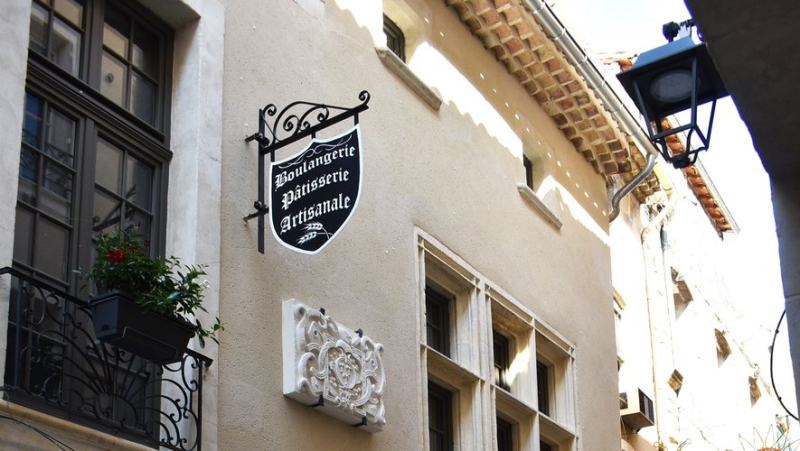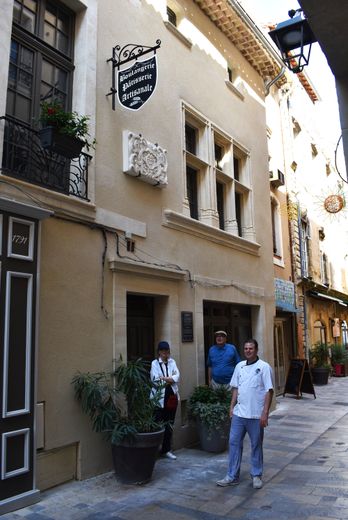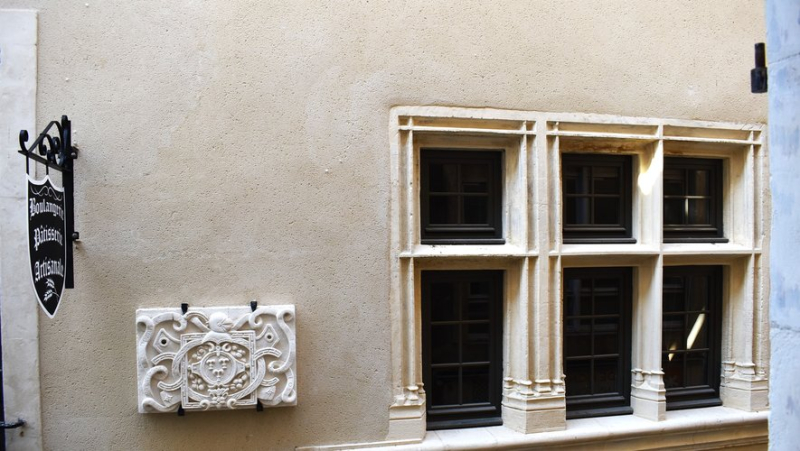Bagnols-sur-Cèze: while renovating his façade on rue Crémieux, baker Alexandre Diard unearthed treasures


Alexandre Diard and his historian accomplices, Martine Jarrié and Antoine Schülé, investigated this old Bagnolaise house and discovered parts of its rich history. Midi Libre – C. C.

The double coat of arms of the Lagorce family and the double-mullioned window from the 14th century. Midi Libre – C. C.

Il a fallu reconstituer et décrypter la devise du blason, avant de refaire faire cette plaque de 120 kg à l’identique. Midi Libre – C. C.
Supported by two local historians, Alexandre Diard conducted the investigation for a year. He found traces of this old Bagnolais house through the centuries. It already existed in 1300. And it has been occupied by artisan bakers since 1791.
“A baker-historian, that's not very common!”, enthuses a specialist of the Cèze valley. Alexandre Diard, who has been delighting the people of Bagnolais for ten years from his artisan bakery on rue Crémieux, has embarked on a historical investigation. While embarking on the project of renovating the facade of the building he acquired at the end of 2022, “we discovered a treasure”, marvels Martine Jarrié, from Bagnols and author of a compendium on the history of the city. And even two treasures. A magnificent double-mullioned window from the 14th century (which has been perfectly restored and highlighted). And a double coat of arms, in pitiful condition, but a rare and exciting discovery. Alexandre Diard delved into municipal and then departmental archive documents.
One of the oldest coats of arms of the Lagorce family, lords of Ardèche and La Roque-sur-Cèze
Life put Antoine Schülé, a local historian, and Martine Jarrié on his path, who seriously supported him. It turns out that this coat of arms isst "one of the oldest of the Lagorce family, originally from Ardèche. The Lagorce were lords of Vallon, Salavas and Lagorce. They became owners of this residence in Bagnols in the 16th century, by alliance, through a marriage with Catherine de Blisson. The lord of Lagorce (Ardèche) became lord of La Roque-sur-Cèze thanks to this marriage. The family remained the owner of the castle of La Roque until the 1950s. From generation to generation, the transmission has always been done by women", underlines Antoine Schülé. The Gardois has carried out substantial research on the lords of Lagorce, lords of La Roque, Boussargues and Saint-Laurent-de-Carnols until 1725.
Chrism, an unexpected character
This exhumed coat of arms is rare: “There is a particular motto around the coat of arms, which was not readable. Alexandre took photos to decipher it. In particular, an unexpected character was missing, the chrism, symbol of Jesus Christ, which I had never seen in Bagnols" continues Antoine Schülé. Once reconstructed, the motto appears: “Sanctus Dominus XP [chrism] statuit pedes meos direxit gressus”, or: “The Holy Lord Jesus Christ set me on my feet and guided my steps.” Two specialist companies were then tasked with reconstructing this imposing 120 kg stone plaque identically. The two historians were impressed on more than one level: “Alexandre has led a respectable and courageous project. This small house has a rich history compared to the modesty of the facade, this is the case for many houses in Bagnols which have a fabulous history” specifies Martine Jarrié, all the more moved as she is the descendant of a Bagnols family of bakers – biscuit makers, “one of the oldest and most beautiful professions”. Antoine Schülé agrees : “It was courageous to have redone the façade as it was originally."
A partly subsidized project
Alexandre Diard is happy : “I went from surprise to surprise. What a discovery ! I have always loved history, and here it touches on my other passion, baking, everything has a meaning!” And everything also has a cost! With the Action cœur de ville program, the facade renovation is subsidized up to 50% according to a defined ceiling. The total cost of the project exceeded this ceiling. The Bâtiments de France meticulously monitored this project. The work lasted a year and a half. The historian-baker registered the building (labeled by the Fondation du patrimoine) for the Heritage Days program. Alexandre Diard now also delights the eyes of those who walk along rue de la Poulagière.
Bakers have occupied this house since 1791
Thanks to this long-term work, Alexandre Diard and his accomplices have reconstructed the history of this private mansion, located at 9 rue Fernand-Crémieux. The building already existed around the year 1300. "We went back to 1422 to find out the successive owners and occupants." Alexandre Diard made some fascinating discoveries: “I was certain that the building had housed a bakery since the beginning of the 20th century.” It turned out that this had been the case since 1791. The first baker to occupy the premises was called Mathieu Joseph Graciany. The Gracianys remained owners of the house for a century, then the Prats family became owners for another century. The following occupants stayed between thirty and forty years. This is why today the front of Alexandre Diard displays the date 1791.
I subscribe to read the rest



